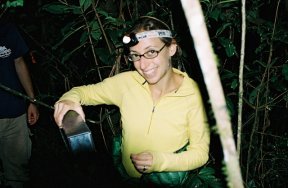News Detective: Emily Observes a Lemur
Share this:
- Share via email (Opens in new window) Email
- Click to share on Facebook (Opens in new window) Facebook
- Click to share on X (Opens in new window) X
- Click to share on Pinterest (Opens in new window) Pinterest
- Click to share on Reddit (Opens in new window) Reddit
- Share to Google Classroom (Opens in new window) Google Classroom
- Click to print (Opens in new window) Print

When I first saw Ziggy, I expected him to act like a rat. After all, he looked a lot like a rodent. He had a tiny body, brown fur, pointy ears, and a long tail.
It was after 9 p.m., and the lab was quiet. Anja turned out the overhead fluorescent lights and gently placed Ziggy at one end of a clear plastic cage. A feather sat at the other end of the cage. It was still early in the research season, and even though Ziggy had participated in her team’s experiments for 3 years, Anja wanted him to spend some time getting used to being in the cage again.
A dim red light glowed nearby, allowing us to watch Ziggy’s behavior. We peered at him through an eyeball-size hole in a dark curtain. As soon as I saw his eyes, I realized that Ziggy was nothing like a rat.
I knew, for example, that rodents rely on their noses. In new situations, they sniff and sniff, using their whiskers to explore. For Ziggy, however, his nose was far less important than his eyes. The two orbs were big, glowing, and, most surprising of all, obviously aware of us.
For many minutes, we stared at Ziggy, and Ziggy stared at us. I admired his adorable face and reflected on how our not-so-distant ancestors might have once looked like this 1.8-ounce creature. His intelligence was obvious, and I wondered what he was thinking.
Slowly, the little primate started to slink along on his stomach toward the feather. He looked at it, looked at us, and looked back at it. This time, I guessed what he was thinking: “Why am I in a box with a feather, while these weird people stare at me?” And maybe most important of all: “Where are the bananas?”
Soon, Ziggy was back in a trap with a banana slice. The researchers were taking him back to his home. They released him into the forest. The next morning, we, too, hopped in a four-wheeled cage to continue our own journey through Madagascar.—Emily Sohn